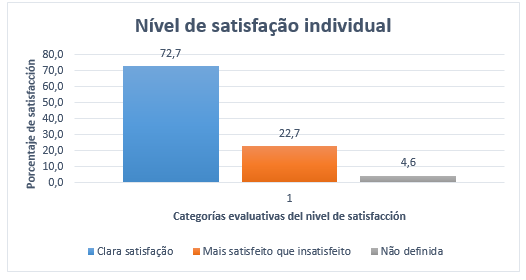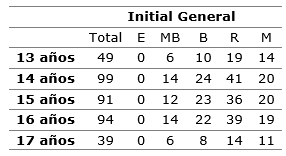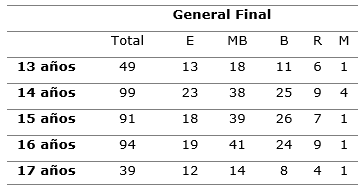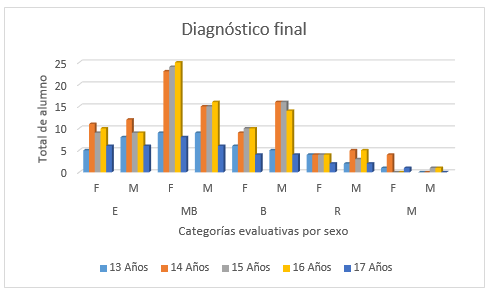Meu SciELO
Serviços Personalizados
Journal
Artigo
Indicadores
-
 Citado por SciELO
Citado por SciELO
Links relacionados
-
 Similares em
SciELO
Similares em
SciELO
Compartilhar
Podium. Revista de Ciencia y Tecnología en la Cultura Física
versão On-line ISSN 1996-2452
Rev Podium vol.16 no.1 Pinar del Río jan.-abr. 2021 Epub 16-Abr-2021
Original article
Procedures for evaluate the physical condition to the students of secondary education in Angola
1Universidad de Las Tunas. Las Tunas, Cuba.
2Universidad de Pinar del Río "Hermanos Saíz Montes de Oca", Facultad de Cultura Física "Nancy Uranga Ramagoza". Pinar del Río, Cuba.
3Instituto Superior de Educación Física y Deporte. La Habana, Cuba.
The research took as its starting point the problematic situation generated by the standards used to assess the physical condition in Angola that do not conform to the real conditions in this country, which result in the design of procedures for the assessment of the physical condition of secondary school pupils in Angola. To this end, both the individual particularities of those evaluated and the environment were taken into account, using different methods and investigative techniques that allowed the proposal to be based, theoretically and methodologically. In particular, everything related to the determination of evaluation standards, using the procedure proposed by Zatsiorski, which allowed the establishment of the different classification groups. In addition, a spreadsheet program was created in Microsoft Excel that automatically evaluates tests. This made it possible to speed up the qualification process and achieve more reliable results of the actual level of physical condition of the students. It concluded with the demonstration of the feasibility of the procedures proposed to evaluate the physical condition, since the rules on leaving their context of origin are no longer relevant, representative and modern. It is also recommended to address other aspects such as the expansion of the sample and the individualization of the evaluation process.
Keywords: Assessment; Physical condition; Norms; Procedures; Tests.
INTRODUCTION
Physical Education contributes to achieve in the child a state of balance and harmony between his movements and his body, his body identity, as well as a directed self-image. For these reasons, it is essential to achieve an optimal physical condition as a way to face the challenges proposed by society. In this sense, it is a necessity to have an evaluation of the level of physical development at different times of the year and stages of a person's life.
For this reason, the evaluation of physical condition has been and is the subject of research by different authors worldwide. In the last five years, research developed by Secchi, García and Arcuri (2016), Benavides et al., (2017), Rosa (2017), Martínez et al., (2017), González and Ramírez (2017), Chang y Pons (2019), Quiala Chang y Pons (2020), Farinola (2020) can be cited, which, as a common feature, seek to adjust the way of evaluating the environment and the evaluated personnel.
Derived from these investigations, developed from the last century, different tests to evaluate physical condition emerged, such as: American Association for Health, Physical Education, Recreation and Dance in 1958, the Canadian Association for Health, Physical Education and Recreation (CAHPER) in 1966, "La Test d' Evaluation de la Condition Physique del' Adulte in 1981, the EUROFIT test of Physical Condition in 1988 (as cited in Rosa, 2017), all, in essence, seek to evaluate as accurately as possible the level reached by the evaluated population.
Nevertheless, the applicability of a standard depends on its relevance, representativeness and modernity (Zatsiorski, 1989). In other words, a test and its evaluation scales cannot be extrapolated from one region to another. However, in Angola, it is evaluated by patterns that do not take into account the characteristics of its population, social, economic and environmental conditions. In the interviews with Physical Education teachers, in the exchange with students, during the review of Secondary Education programs and in the observations of the application of the physical condition tests, the following inadequacies were identified:
Existence of a diversity of criteria on how to evaluate physical condition. Consequently, teachers fail to comply with metrological requirements that affect the reliability and validity of the results achieved by students.
The standards established by age and sex do not take into account individual and socio-environmental particularities. As a consequence, there are manifestations of rejection of these tests, muscular injuries and extreme fatigue.
In the search for information on this problem, several authors with different points of view were consulted. In this sense, they are grouped in three aspects: the first and oldest one proposes to evaluate the load in its external dimension. In this group, those cited by Quiala, Changy Pons (2020) stand out, such as Grosser, Starischka and Zimmermann (1988), Pila (1989), Generelo and Tierz (1991) Ruiz, Rodríguez and Sasco (2007) Roland (2009). For them, the most important thing is to determine how flexible, fast, strong and resilient a person is.
In the second aspect, according to Quiala, Chang and Pons (2020), authors such as Bouchard, Shephard, Stephens, Sutton and McPherson (1990), Arce, Martínez and Elorza (1996), Tercedor (2001), Delgado and Tercedor (2002) and Latorre and Herrador (2003) assume the internal dimension of the load as a determinant. In their opinion, the most important thing is how the organism responds to achieve the external result obtained in each test.
Finally, in the third aspect are grouped what is expressed by Quiala, Changy Pons (2020) and authors such as Jeffers (2004), Quiala (2009) and Pacheco (2014), who consider the need to take into account both dimensions; this criterion is also shared by the authors of this research, since both complement each other.
Based on the analyzed criteria and the detected insufficiencies, it is determined that the standards currently used in Angola to evaluate the physical condition in Secondary Education do not allow a reliable evaluation of the level reached by the students in the course, which is manifested in the results of the tests carried out. Therefore, when undertaking the research, the objective is to design methodological procedures to evaluate the physical condition of the students of the 1st cycle of Secondary Education in Kilamba, based on their individual particularities and those of their environment.
MATERIAL AND METHODS
For the development of this research, in the context of the Republic of Angola, it was decided to assume the definition of physical condition, given by Quiala, W., (Quiala, Chang & Pons, 2020) by considering it as a.
"product of exercise, of physical preparation and which represents a satisfactory state of development of the capacities and motor skills of the individual, in correspondence with his age, sex, weight and height" (p.53).
This is because the most commonly used tests in this country evaluate conditional capacities and flexibility. On this basis, the methodological procedures proposed as a solution to the problem posed were designed.
Population and sample
The research population consisted of the students of the "11 de Julho" school, 1st cycle of Secondary Education in Kilamba, Belas municipality, Luanda province, Angola, with an enrollment of 1,860, distributed in 58 groups and two sessions. A stratified probability sample was selected that included five age groups from 13 to 17 years of age. These, in turn, were subdivided by sex; the proportion of students in each stratum and subgroup is equivalent to the population.
To determine the sample size, the formula established for a known population was used. As a significance level for the investigation, a 95 %, standard deviation of 0.55 was assumed, determined by the values reached in the general level of the previous year. In addition, an error of 0.05 was estimated.
Based on these data, it was determined that the sample should be composed of 372 students, who were distributed by strata, as follows.
13 years: 49 (25 female (F) and 24 male (M).
14 years: 99 (51 F and 48 M).
15 years: 91 (47 F and 44 M).
16 years: 94 (49 F and 45 M).
17 years 39: (21 F and 18 M).
Finally, simple random sampling was used to select the members of each stratum. In addition to the students, information was obtained from 14 teachers who were also selected as a sample. Their average age is between 26 and 50 years old. With an average work experience of 13 years, the youngest have at least four years and the oldest 17 years. Of these, three have a degree in Physical Education and Sport and the rest are in different years of this degree.
The main methods and techniques used in the research were the following:
Analytical-synthetic, inductive-deductive, systemic-structural-functional, observation, interview, survey and users' criteria. These methods made it possible to provide a theoretical basis for the research, determine the inadequacies in the physical condition evaluation process, elaborate the proposed solution to the problem and verify its validity.
In this sense, the application of the tests used by the teachers was observed, as well as the way of evaluating them. In addition, they were interviewed and surveyed to find out how they used the results obtained to plan their classes.
The Iadov technique (López & González, 2001) made it possible to determine the level of individual and group satisfaction of the Physical Education teachers of the 1st cycle of Secondary Education of the Kilamba centrality, with respect to the way of elaborating the norms and on the spreadsheet program, designed for the process of grading the test.
The statistical-mathematical methods used were: the empirical distribution of frequencies and their corresponding percentage distributions. In addition, inferential statistics were used to evaluate whether the difference between the initial and final diagnosis was significant through the Wilcoxon signed ranks test.
This research allowed solving a practical problem throughout the 2019 school year, so it has a provisional character, where the aspects observed and measured in the field were quantified. In addition, emphasis was placed on the particularities of the community, therefore, it is a field study, longitudinal and quantitative.
The analysis carried out on the theoretical considerations, related to physical condition, made it possible to assume that there are several determining factors of the level reached by a person during the year. However, for the development of this research, in the 11 July school of the Kilamba centrality, only the following were taken into account: body composition (Body Mass Index (BMI)), the development of conditional physical capacities (speed (50m. run), strength (planks, sit-ups and horizontal jump) and endurance (1000m. run) and flexibility (ventral flexion from the sitting position), as well as the socio-environmental conditions. In this sense, the following procedures were designed:
Determination of the requirements for the development of physical condition evaluation standards.
Preparation of the evaluating personnel.
Standardization of the test.
Automation of the scoring process.
Follow-up of the results of the physical condition test in Physical Education classes.
The requirements for elaborating the physical condition evaluation standards were as follows:
Elaboration of a standardization for the test, as strict as possible.
The norms elaborated on the basis of the results achieved by the students in the initial diagnosis.
The use of the arithmetic mean and standard deviation in the elaboration of the norms, as established by Zatsiorski (1989), but, with five classificatory groups. That is, from "Excellent" to "Poor".
In speed, if the standard deviation is less than or equal to 0.02 seconds, then use this value (0.02 seconds) as the standard deviation.
In endurance, if the standard deviation is less than or equal to 2 seconds, then use this value (2 sec.) as the standard deviation.
In flexibility and horizontal jump, if the quality deviation is less than or equal to 2 cm, then use this value (2 cm) as the quality deviation.
In planks (push-ups) and sit-ups, if the standard deviation is less than or equal to 2 repetitions, then use this value (2 repetitions) as the standard deviation.
For the flexibility, quickness and horizontal jump tests, use two attempts and choose the best one.
The preparation of the evaluation personnel was aimed at increasing the level of theoretical and methodological knowledge related to test theory. In addition, the necessary skills were developed to increase the reliability of the results. To this end, several theoretical and practical classes were held in April and May.
In the standardization of the test, all the necessary elements were included for the control of variables that could alter the reliability of the results, such as:
Name of the test.
Objective of the test.
Organization of the test.
Development of the test.
Sketch of the test.
Other organizational elements were:
Day of the week it is applied.
Time at which it is applied.
Time measuring instrument (basic error).
Weight measuring instrument (Basic error).
Length measuring instrument (Basic error).
Time of rest.
Nature of the rest and how to do it.
Data on personnel evaluated
Name.
Age.
Sex.
Clothing.
Footwear.
Data of the evaluating staff
Principal evaluator.
Timekeeper.
Annotated:
Auxiliary staff data
A spreadsheet program was designed to automate the grading process. It groups all students with equal age and gender. In each sheet, the following data were collected: name, weight, height, body mass index (BMI), flexibility, speed, arm strength, abdominal strength, vertical jump, horizontal jump, endurance and general level (Figure 1).
The quantitative evaluation was carried out on the basis of 20 points, which correspond to the qualitative evaluations. In this sense, the spreadsheet program was designed to elaborate a norm for each test and, from the integration of all of them, to determine the general level. With it, both initial and final evaluative moments were evaluated. For the development of this process, the results of the first diagnosis were taken as starting data.
Each test had a score that was the result of the following mathematical operation (Equation 1).
For the time-related tests (speed and endurance) (Equation 2).
Where:
"R" |
is the record achieved in the test. |
"20" |
is the base value of the evaluations in Angola. |
"X" |
is the mean of the records achieved by the age group in that test. |
"S" |
is the standard deviation of the records achieved by the group, with the same age and sex in that test. |
The evaluation of the general level was based on the arithmetic mean of the values achieved in each of the tests. In order to establish the correspondence between the quantitative and qualitative scales, the following relationships were used:
To follow up the results of the physical condition test in the Physical Education classes, a summary table was used, created by the spreadsheet program (Figure 2) . This made it possible to determine which capacity was most affected, as well as the students with the greatest deficiencies. In this way, the teachers were able to distribute the content objectively. In other words, they assigned a greater number of classes to the most needed skills. In addition, it made it possible to direct attention to individual differences.
RESULTS AND DISCUSSION
In order to test the validity of the proposal for the evaluation of the physical condition of the students of the "11 de Julho" school of Kilamba, in the first cycle of Secondary Education, a set of tests was applied. It was carried out in two stages: the first from June 3 to 7 and the second from October 7 to 11. The results obtained in the initial diagnosis for each age group were the following (Table 1).
With the application of the initial diagnosis, it was found that, in general, there is a low level of physical condition in the students taken as a sample, as can be seen in the totals by evaluation category (Excellent "E", Very Good "MB", Good "B", Regular "R", Bad "M"), (Table 1). In this sense, more than 60 % of the enrollment, in all age groups, is evaluated as R and M. Of these, the most affected are the 13 year-olds, with 67.3% and the 17 year-olds, with 64.1 %.
When analyzing how the initial diagnosis behaved by sex (female "F" and male "M"), it was also necessary to group them by evaluative categories and age groups (Figure 3). In the graph, it can be seen that males present a higher percentage of those evaluated as R and M. In this sense, most of them are above 65 %, with the exception of the 16 year-old age group, with 62.2 %. The same does not occur in the female group, which is closer to 60 %, except for the 13-year-old female students, with 68 %.
Regarding BMI behavior, it was found that there are several students with "underweight", 31 in the female sex and 45 in the male sex. In this sense, most of the enrollment is evaluated as "normal weight", however, the average values are close to the lower limit. On the other hand, although there are manifestations of "overweight", the values are close to the upper limit of what is considered normal by the WHO (CDC Centers for Disease Control and Prevention, 2020).
On the other hand, the use of the spreadsheet program in the process of scoring the test also provided the main weaknesses of the different age groups and individual inadequacies. In this way, the work was focused on solving them, both during and outside of Physical Education classes. These elements allow improving the effectiveness of the teacher's activity and favor the students' interest in overcoming their initial results.
In order to evaluate the progress achieved, the test was applied again from September 23 to October 5. Compliance with all the requirements established in the standardization was taken into account to avoid the effects caused by additional errors. By simple inspection, favorable results were observed (Table 2). In this sense, the students evaluated for R and M, in all age groups, are below 15 %, with the 17 year olds standing out with 8.8 %.
Similarly, the behavior of the results was analyzed by sex, evaluation category and age (Figure 4). It is observed, in relation to those evaluated in R and M, a distribution with greater percentage dispersion in the female sex (8.2 % to 20 %), with respect to the male sex (8.3 % to 13.3 %). Nevertheless, there is a favorable change in the evaluation, with respect to the initial test. This is influenced by the work carried out in the Physical Education classes, by focusing attention on the detected insufficiencies and by adjusting the demands to the particularities of the students and their environment.
In order to verify whether the changes observed in the level of physical condition of the students during the final diagnosis were significant, the Wilcoxon test was used, at the 0.05 level. The results show a significance of ,000 which shows that they are significantly higher than the initial ones. Therefore, the adjustment of the norms to the material and environmental conditions of the school, together with the individual particularities, provides a higher level of reliability to the test results.
On the other hand, the Iadov technique was applied to the teachers to find out their level of satisfaction with this way of evaluating the physical condition of their students. The results of the individual satisfaction index (Figure 5) indicate that 95.4 % are clearly satisfied or more satisfied than dissatisfied with the proposal for the evaluation of physical condition in the 1st cycle of Secondary Education in Kilamba, Angola.

Fig. 5 - Behavior of teachers' individual satisfaction level with respect to the form proposed in the research to evaluate physical condition in Secondary Education in Kilamba, Angola
The calculation of the group satisfaction index (Figure 6) shows that the Physical Education teachers are satisfied with the proposal. When analyzing the answers to the question: What are the aspects that need to be improved? They refer to administrative and organizational problems. Among these are the location of Physical Education shifts in the school schedule and material limitations.

Fig. 6 - Behavior of teachers' group satisfaction level with respect to the proposal to evaluate the students' physical condition in Secondary Education in Kilamba, Angola
On the other hand, to the question: What would you do to improve the way of evaluating the physical condition of the students in your school? The responses with the highest level of coincidence are expressed around the need to take into account the weight/height ratio in the evaluation; in this way, it would be much fairer. These criteria are based on the results shown when calculating the BMI, since 20.4 % of the sample is evaluated as "underweight". This is an element to be taken into account for the improvement of this proposal.
CONCLUSSIONS
The results obtained with the application of the methodological procedures designed to evaluate the physical condition of Secondary Education first cycle students of the centrality of Kilamba, Angola, based on their particularities and those of the environment, allowed confirming their effectiveness and feasibility. In addition, they confirmed that the standards, when they leave their original context (the universe from which they were obtained), cease to be relevant, representative and modern. These metrological aspects should always be taken into account if a reliable evaluation of the level of physical condition of a given population is to be obtained.
REFERENCIAS BIBLIOGRÁFICAS
Benavides, C., García, J., Fernández, J., Rodrígues, D., & John, A. (2017). Condición física, nivel de actividad física y capacidad funcional en el adulto mayor: instrumentos para su cuantificación. U.D.C.A Actualidad & Divulgación científica, 20(2), 255-265. https://doi.org/10.31910/rudca.v20.n2.2017.385 [ Links ]
Centers for Disease Control and Prevetion CDC (2020). Healthy Weight, Nutrition, and Physical Activity. About Child & Teem BMI. https://www.cdc.gov/healthyweight/assessing/bmi/childrens_bmi/about_childrens_bmi.html [ Links ]
Farinola, M. G. (2020). Propuesta de evaluación de la condición física para población general: Batería Dickens. Educación Física y Ciencia, 22(1), e114. https://www.efyc.fahce.unlp.edu.ar/article/download/EFyCe114/12236?inline=1 [ Links ]
González Rico, R., & Ramírez Lechuga, J. (2017). Revisión de las pruebas de evaluación de la condición física en Educación Secundaria. Ágora para la educación física y el deporte, 19(2-3), 355-378. https://dialnet.unirioja.es/servlet/articulo?codigo=6261767 [ Links ]
López, A., & González, V. (2002). Técnica de Iadov. Efdeportes, Revista Digital - Buenos Aires, 8(47). https://www.efdeportes.com/efd47/iadov.htm [ Links ]
Quiala Barroso, W., Chang Girón, Y. C., & Pons Núñez, A. M. (2019). Alternativa metodológica para la evaluación de la condición física en las escuelas primarias rurales. Olimpia, 16(56), 183-195. https://revistas.udg.co.cu/index.php/olimpia/article/view/915 [ Links ]
Quiala Barroso, W., Chang Girón, Y. C., & Pons Núnez, A. M. (2020). Ventajas de una alternativa metodológica para la evaluación de la condición física en la educación primaria. Mundo FESC, 10(S1), 49-59. https://www.fesc.edu.co/Revistas/OJS/index.php/mundofesc/article/view/395 [ Links ]
Rosa Guillamón, A. (2017). Análisis bibliográfico de las baterías de evaluación de la condición física. Revista Peruana de ciencia de la actividad física y del deporte, 4(4), 533-543. https://www.researchgate.net/profile/Andres_Guillamon/publication/323759194_Analisis_bibliografico_de_las_baterias_de_evaluacion_de_la_condicion_fisica_Bibliographic_analysis_of_ the_physical_fitness_assessment_batteries/links/5aa960d7aca272d39cd5201c/Anal [ Links ]
Secchi, J. D., García, G. C., & Arcuri, C. R. (2016). Evaluación de la condición física relacionada con la saluden el ámbito escolar_ un enfoque práctico para interpretar e informar los resultados. Enfoques, XXVIII (2), 67-87. https://www.redalyc.org/pdf/259/25955334004.pdf [ Links ]
Zatsiorski, V. M. (1989). Metrología Deportiva. Moscú, Rusia: Ed. Planeta. [ Links ]
Received: August 14, 2020; Accepted: November 12, 2020











 texto em
texto em 











